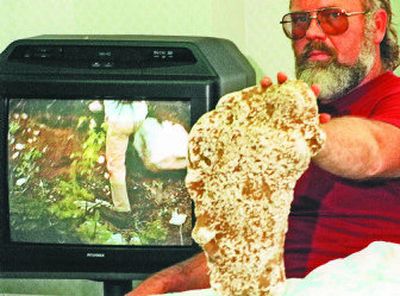Sasquatch sightings abound

Last of three parts
Seen anything strange lately? Ever been camping, hiking or hunting and seen something you couldn’t explain? Ever seen or heard something out in the wilderness that was so strange you decided not to mention it to anyone for fear of ridicule?
Lots of people in the Blue Mountains near Walla Walla, in the forests of northeastern Washington and throughout North Idaho, including Kootenai County, would have to answer “yes” to at least one of those questions.
Whether or not they want to admit it, a lot of people in our region think they have seen or heard something that might have been evidence of a sasquatch.
How do I know this?
I know because a few brave souls have come forward over the years with stories, with plaster casts of footprints, with recorded sounds and even with some shaky video.
Lots of people, from lots of walks of life, with high levels of credibility, reluctantly have told their tales. They are not, for the most part, publicity seekers. Their stories do not, for the most part, come from places where it would be likely that a hoax could have been perpetrated upon them.
What do you think? Could all of this have been made up or simply imagined?
Let’s look at the record.
In North Idaho and northeastern Washington, no fewer than 36 recent sightings have been reported of a tall, apelike, upright-walking animal or of sets of large, bipedal tracks that weren’t made by a human or a bear. This is based on information from the Bigfoot Field Researchers Organization(Web site: www.bfro.net).
Eighteen of those reports include at least one sighting in each of the counties in Idaho from Nez Perce County north, with four each in Kootenai and Bonner counties. The other half are from Spokane, Stevens and Pend Oreille counties in northeastern Washington.
Some of those sightings probably are deceptions played upon innocent observers. Some of them probably are misidentifications. Some of them probably are lies. But could all these reports be dismissed in these ways?
For example, what about this report from the recent book “Sasquatch: Legend Meets Science” by Professor Jeffrey Meldrum of Idaho State University?
When: 1977.
Who: A couple from Blanchard, Idaho.
Where: A dirt road on Mount Spokane.
What: The couple observed a large hairy creature making its way up the mountainside.
Later, experienced tracker Wayne Rasmussen found 17.5-inch footprints that he tracked for “a considerable distance.” He made an acrylic resin cast of a footprint that initially was studied by Professor James McLeod, of North Idaho College, and a student, John Witherow.
Meldrum was able to identify dermal ridges – “sasquatch fingerprints” – similar to those found on other tracks from other areas over a long period of time.
A more recent example, reported in The Spokesman-Review on June 3, 1997.
Who: Gene Woodruff and son from Kelso Lake, Idaho.
Where: National forest north of Priest River, Idaho.
What: Woodruff’s son found a 14-inch humanlike, three-toed footprint from which the pair made a plaster cast.
The four recent Kootenai County sighting reports came from about 10 miles north of Hayden along U.S. Highway 95 (seen by a police officer in 1995), from the mountains east of Lake Coeur d’Alene’s Beauty Bay (a track), from above Lake Fernan at Fernan Saddle (seen by three people in 2003) and from Buckles Mountain east of Garwood (tracks seen by a husband and wife in 2005).
Recent accounts also have come from areas near Wallace of sasquatchlike sounds (2004), near Clark Fork of footprints and unique howls (2006), between St. Maries and Potlatch of a creature crossing the road (seen by three people in 2003) and on Moscow Mountain of a 20-minute observation of a sasquatch nursing a young offspring (seen by a geologist and a friend in 2005).
Much more active in terms of sasquatch sightings and signs are the Blue Mountains outside Walla Walla. From a three-county area in those mountains, the Bigfoot Field Researchers Organization lists 32 recent reports.
Books could be written on purported Bigfoot activity in this area, and they have been.
Vance Orchard was a newspaper reporter in the Walla Walla area for 55 years and wrote about most of the sasquatch sightings in the Blue Mountains, beginning with an article in 1966 and continuing until his death a year ago.
Orchard wrote two books on the Walla Walla sasquatch, “Bigfoot of the Blues” (1993) and “The Walla Walla Bigfoot” (2001), both of which are out of print but still available in the used-book trade. The stories are fascinating and compelling.
The Walla Walla bottom line is that there is a lot of evidence of a family of three sasquatches having lived in a protected watershed and adjacent wilderness area for at least three decades.
There may be others as well, based on numerous sightings, thousands of tracks and a history in the Blue Mountains going back to 1900.
So what do you think? Is there sufficient evidence of an apelike sasquatch that you would not be surprised if one finally were killed or captured?
I’m not going to ask you if you believe in Bigfoot. Bigfoot is not a religion to be believed in or not.
Meldrum explains: “I am frequently asked, ‘Do you believe in sasquatch?’ I invariably and firmly reply that a question of belief is simply not at issue. Belief generally connotes the acceptance of something as true in the absence of objective evidence or conclusive proof. It usually is equated with a position of faith.”
Is the objective evidence sufficient? In the absence of conclusive proof, is the issue of the existence of sasquatch a legitimate scientific question worth having scientists look into?
To Meldrum and an increasing number of other well-credentialed scientists with whom he has discussed the subject, “the evidence is intriguing, if not outright persuasive and compels to further investigation.”
So, they would answer with a firm “yes.”